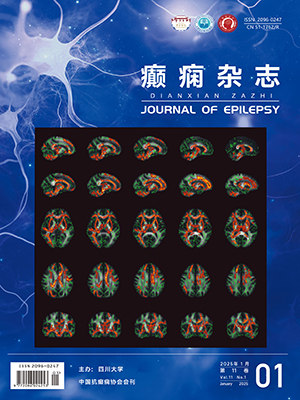| 1. |
Hirsch LJ, Claassen J, Mayer SA, et al. Stimulus-induced rhythmic, periodic, or ictal discharges (SIRPIDs): a common EEG phenomenon in the critically ill.Epilepsia, 2004, 45(2): 109-123.
|
| 2. |
Hirsch LJ, LaRoche SM, Gaspard N, et al. American clinical neurophysiology society's standardized critical care EEG terminology: 2012 version.Clin Neurophysiol, 2013, 30(1): 1-27.
|
| 3. |
Hirsch JL, Pang T, Claassen J, et al. Focal motor seizures induced by alerting stimuli in critically ill patients.Epilepsia, 2008, 49(6): 968-973.
|
| 4. |
Steriade M.Arousal: revisiting the reticular activating system.Science 1996, 272(5259): 225-226.
|
| 5. |
Steriade M.Corticothalamic resonance, states of vigilance and mentation.Neuroscience, 2000, 101(2): 243-276.
|
| 6. |
Steriade M.Synchronized activities of coupled oscillators in the cerebral cortex and thalamus at different levels of vigilance.Cereb Cortex, 1997, 7(6): 583-604.
|
| 7. |
Anzelloti F, Franciotti R, Onofrj M.Stimulus aborted periodic epileptiform discharges: a case description and possible relationship with stimulus induced discharges.Epilepsy Res, 2013, 105(1-2): 256-259.
|
| 8. |
Zeiler SR, Turtzo LC, Kaplan PW.SPECT-negative SIRPIDs argues against treatment as seizures.ClinNeurophysiol, 2011, 28(5): 493-496.
|
| 9. |
Smith CC, Tatum WO, Gupta V, et al. SPECT-negative SIRPIDs: less aggressive neurointensive care.ClinNeurophysiol, 2014, 31(3): e6-e10.
|
| 10. |
Alvarez V, Oddo M, Rossetti AO.Stimulus-induced rhythmic, periodic or ictal discharges (SIRPIDs) in comatose survivors of cardiac arrest: characteristics and prognostic value.Clin Neurophysiol, 2013, 124(1): 204-208.
|
| 11. |
Fluri F, Balestra G, Christ M, et al. Stimulus-induced rhythmic, periodic or ictal discharges (SIRPIDs) elicited by stimulating exclusively the ophthalmic nerve.Clin Neurophysiol, 2008, 119(8): 1934-1938.
|
| 12. |
Nascimento FA, Borlot F, Aljaafari D, et al. Search for epileptiform electroencephalogram activity by external stimulation in critically ill patients.Can J Neurol Sci 2016, 43(5): 710-712.
|
| 13. |
Tjepkema-Cloostermans MC, Wijers ET, van Putten MJ.Stimulus induced bursts in severe postanoxic encephalopathy.Clin Neurophysiol, 2016, 127(11): 3492-3497.
|
| 14. |
Chatrian G, Shaw C, Leffman H.The significance of periodic lateralized epileptiform discharges in EEG: an electrographic, clinical and pathological study.Electroencephalogr Clin Neurophysiol, 1964, 17: 177-193.
|
| 15. |
Fisch BJ, Klass DW.The diagnostic specificity of triphasic wave patterns.Electroencephalogr Clin Neurophysiol, 1988, 70(1): 1-8.
|
| 16. |
Fernandez-Torre JL, Hernández-Hernández MA.Acute stimulus-sensitive postanoxic myoclonus: the importance of sensory stimulation in comatose patients.Clin EEG Neurosci, 2012, 43(4): 312-314.
|
| 17. |
Koutroumanidis M, Tsatsou K, Bonakis A, et al. Stimulus-induced bilateral central periodic discharges, cortical myoclonus and arousal responses in mild reversible coma.Clin Neurophysiol, 2008, 119(11): 2459-2464.
|
| 18. |
Rossetti AO, Dunand M.Creutzfeldt-Jakob disease: evolution from nonconvulsive status epilepticus, through SIRPIDs, to generalized periodic discharges.Clin Neurophysiol, 2007, 118(11): 2533-2538.
|
| 19. |
Emily J, Yousef H, Nirma CM, et al. Cefepime-associated SIRPIDs in a patient with normal renal function.The Neurohospitalist, 2016, 6(4): 167-169.
|
| 20. |
Murphy MM.SlRPIDs: a case study.Am J END Technol, 2006, 46(2): 159-164.
|
| 21. |
Ong C, Gilmore E, Claassen J, et al. Impact of prolonged periodic epileptiform discharges on coma prognosis.Neurocrit Care, 2012, 17(1): 39-44.
|
| 22. |
van Straten AF, Fesler JR, Hakimi R, et al. SIRPIDs: Prevalence and outcome in critically ill patients.Clin Neurophysiol, 2014, 31(5): 418-421.
|
| 23. |
Braksick SA, Burkholder DB, Tsetsou S, et al. Associated factors and prognostic implications of stimulus-induced rhythmic, periodic, or ictal discharges.JAMA Neurology.2016, 73(5): 585-590.
|
| 24. |
Chong DJ, Hirsch LJ.Which EEG patterns warrant treatment in the critically ill Reviewing the evidence for treatment of periodic epileptiform discharges and related patterns.Clin Neurophysiol, 2005, 22(2): 79-91.
|




